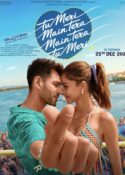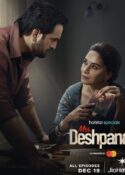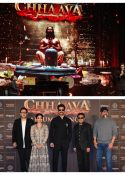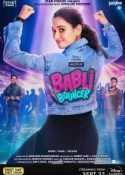 After seeing the epic historic spectacle of Vicky Kaushal’s Chhaava, Subhash K Jha revisits Jodhaa-Akbar celebrating the brilliant film that starred Hrithik Roshan and Aishwarya Rai. As a special bonus, the director reveals some fascinating facts about the making of the film.
After seeing the epic historic spectacle of Vicky Kaushal’s Chhaava, Subhash K Jha revisits Jodhaa-Akbar celebrating the brilliant film that starred Hrithik Roshan and Aishwarya Rai. As a special bonus, the director reveals some fascinating facts about the making of the film.
Jodhaa-Akbar is watchable as a splendidly spiced-up slice of history. Or just savour the chemistry between the warrior and the princess, with hundreds of junior artistes, elephants, rabbits, and parrots accompanying the couple’s journey. This historic moment that takes us beyond the dynasties of Mughal history couldn’t have been possible without Hrithik’s amazing capacity to infiltrate the portals of divinity through dance movements.
As we traverse the simply stunning spectacle of Ashutosh Gowariker’s historical epic, often wonder-eyed and open-mouthed, we end up looking at Akbar as interpreted by Hrithik rather than as what the Mughal legend might have been.
The body language of the sword-wielding poet-warrior Hrithik Roshan reminds us of Mel Gibson in Braveheart and Tom Cruise in The Last Samurai rather than Prithviraj Kapoor, who played Akbar in K. Asif’s undying classic Mughal-e-Azam with such imposing imperiousness.
In terms of the creative and visual terrain covered in the three-hour, 20-minute journey, Gowariker’s vision subsumes a reined-in wealth of ideas and images into an opulent but aesthetic tale of love, romance, war, hatred, and secularism. The director transports us into an era when brother battled brother in a bitter rage. But love blossomed in the heart of a secular Muslim emperor who married a fiercely individualistic Rajput princess and allowed her space to be her own person.
The narrative patterns Akbar’s chequered life of love and wars through the various characters who influence his mind and heart. To begin with, we see the young Akbar being moulded into a violent person, brimming with ideas of revenge and acquisition by his senapati-mentor Bairam Khan.
In a frightening burst of vengeful brutality, we see Akbar ordering his soldiers to throw a stubborn adversary head-first to death. But all said and done, Gowariker’s Akbar is a man who’d rather live in peace than wallow in war. Alas, Akbar lived in violent, battle-friendly times.
Then there’s the complex relationship that Akbar shares with his foster mother, played by Ila Arun. But the friction between the foster mother and Akbar’s new bride could be straight out of Indra Kumar’s Beta!
Gowariker also purposely brings in kitschy elements from commercial cinema to provide a kind of warm accessibility to his historic tale.
Never before have we seen battle sequences so spectacular and energetic in Hindi cinema. Take the opening sequence, where the battle lines close ranks in such passionate movements that the audience almost feels trampled in the middle. Kiran Deohans’ swift but sublime cinematography is of international calibre, on a par with Gladiator or Braveheart.
A.R. Rahman’s music is a bit of a letdown, though. Veering between authenticity and listener-friendliness, it’s a mellow mishmash, signifying none of those enchanting echoes of Jodha and Akbar’s everlasting romanticism.
Though the filming of the Durbar song ‘Azeem-o-shaan Shahenshah’ is the last word in the spectacle. Breathtaking is the word that often comes to mind in this tale of vibrant valour and vitality.
The love story occupies the pride of place in Jodhaa-Akbar. The sudden marital alliance between the benign king and the free-spirited Rajput princess, their post-marriage courtship, the misunderstanding that cuts through their growing fondness, and the final and irreversible reconciliation, are portrayed with exquisite fluidity.
Not once does the director allow the inherent opulence of his theme to overpower the love that grows between them. Hrithik’s pleading, poetic eyes in a warrior’s face define the historic romance as much as Aishwarya’s swan-like grace and passionate individualism. After Dhoom 2, this pair surely whips up a Mughlai feast of passion and romance.
Ashutosh Gowrikar On Jodhaa-Akbar
After Lagaan, you returned to a period film in Jodhaa-Akbar?
You might say that. But I call Lagaan a period film. Jodhaa-Akbar is to me a historical. Anything after 1857 is a period film for me. Anything before that is a historical. Jodhaa-Akbar is certainly not a costume drama. It isn’t set in a never-never land. I’d call Mughal-e-Azam a historical, though its focus was different from mine. I feel if today we make a story about the past it must be co-related to the present. And Jodhaa-Akbar is as relevant to present times as arranged marriages. Jodha and Akbar shared a perfectly arranged marriage. I was fascinated by how their relationship must have grown after marriage. There was no reference in any books about what happened between them. I took extreme care to make sure viewers believe in the relationship.
How much did you stress the religious differences between Jodha and Akbar?
It’s important but not stressed in my film. Let’s not forget, Akbar’s marriage to Jodhabai was no common occurrence. It had a nationwide reverberation 450 years ago when society was far more conservative. How did their marriage affect those times? That’s a question relevant even today. But I was not jingoistic in my treatment.
Aishwarya Rai and Hrithik Roshan have very contemporary personalities?
That wasn’t a problem. The audience came in and forgot everything about Hrithik and Aishwarya. The two were brilliant. Ultimately, the audience was watching not the stars but the two characters that they play. Hrithik-Aishwarya’s pairing was incredible. They’re extremely charismatic and good-looking. They were a huge success in the contemporary Dhoom 2. What audiences saw in my film were Jodha and Akbar. At least, that’s what I tried to ensure through their looks, body language, and behavior. I wanted to make my historical as believable as I’d like to see it being. Every element, big or small, from the texture of the clothes to the sets, décor, dialogues, and the protocol, even the incidental sounds of birds and animals, all had to be just right for me. I’m tired of filmmakers wondering where those good old days have gone. I wanted to reclaim those days. It took me two years of pre-production before I got into my first shot.
Is this the most difficult you made?
It is. But the process has been so enjoyable I didn’t mind the toil. My crew made the process of creation very interesting. Just working hard isn’t a virtue. Otherwise, I should not make a film. And I definitely shouldn’t make a historical.
Film analysts feel history has no relevance for today’s average youngster?
I agree. Even as a child myself historical films never interested me. But when I saw Mughal-e-Azam on television, I connected with it because it was a story of lovers separated by parental opposition. That the parents were historical figures was incidental. I feel the story has to be connectable to the audience. Hyder Ali, who wrote Jodhaa-Abkar, told me, ‘In Mughal-e-Azam the focus was so much on Salim and Anarkali nobody asked a fundamental question. How did Akbar come to marry Jodhabhai in spite of their religious and cultural divide?’ I immediately reacted to their alliance. I saw an interesting story there that needed to be told. As for the youngsters, I had one rule of connectivity in my range of vision. Any word or dialogue that I didn’t understand in Urdu, I kept out. I’ve no interest in impressing audiences with my knowledge of Urdu, Hindi, or even literature. I feel literature is for the books, and that’s where it should stay. I needed to reach out to the masses.
So was Jodhaa-Akbar kitsch?
No. I referred to literature and academia. But the Akbar-nama was in Pharsi. It doesn’t mean I’d use Pharsi in my film. I wanted Tamil Nadu, Kerala, and Bengal to understand the film. Each language has its own regality and I’m going by the individual regality of the province. I had one vision before me when I started making this film. It was the world of the Amar Chitra Katha. I’ve grown up in that world. So far, the Mughal period was part of textbooks. I always wondered about the battles and the Durbar intrigue. The Mughal period was known for its lavishness, so much so that studio bosses in Hollywood from the golden period were not called movie czars or movie nawabs. They were called movie moguls.












